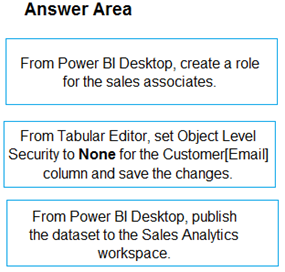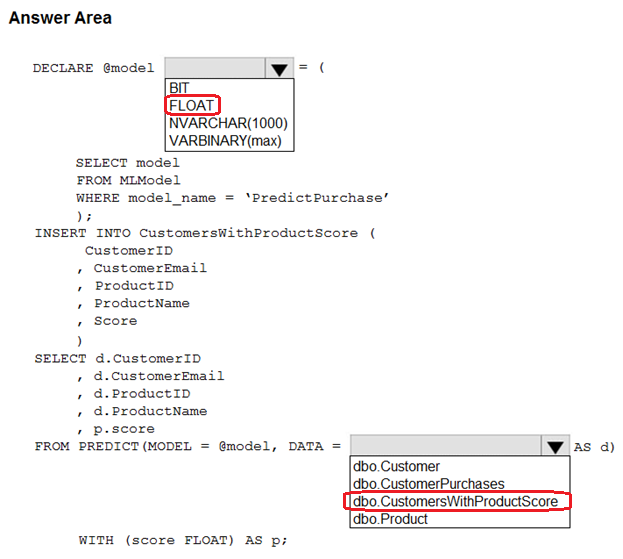Microsoft DP-500 Exam Practice Questions (P. 3)
- Full Access (194 questions)
- Six months of Premium Access
- Access to one million comments
- Seamless ChatGPT Integration
- Ability to download PDF files
- Anki Flashcard files for revision
- No Captcha & No AdSense
- Advanced Exam Configuration
Question #11
DRAG DROP -
This is a case study. Case studies are not timed separately. You can use as much exam time as you would like to complete each case. However, there may be additional case studies and sections on this exam. You must manage your time to ensure that you are able to complete all questions included on this exam in the time provided.
To answer the questions included in a case study, you will need to reference information that is provided in the case study. Case studies might contain exhibits and other resources that provide more information about the scenario that is described in the case study. Each question is independent of the other questions in this case study.
At the end of this case study, a review screen will appear. This screen allows you to review your answers and to make changes before you move to the next section of the exam. After you begin a new section, you cannot return to this section.
To start the case study -
To display the first question in this case study, click the Next button. Use the buttons in the left pane to explore the content of the case study before you answer the questions. Clicking these buttons displays information such as business requirements, existing environment, and problem statements. If the case study has an All Information tab, note that the information displayed is identical to the information displayed on the subsequent tabs. When you are ready to answer a question, click the Question button to return to the question.
Overview -
Existing environment -
Litware, Inc. is a retail company that sells outdoor recreational goods and accessories. The company sells goods both online and its stores located in six countries.
Azure Resources -
Litware has the following Azure resources:
An Azure Synapse Analytics workspace named synapseworkspace1
An Azure Data Lake Storage Gen2 account named datalake1 that is associated with synapseworkspace1
A Synapse Analytics dedicated SQL pool named SQLDW
Dedicated SQL Pool -
SQLDW contains a dimensional model that contains the following tables.
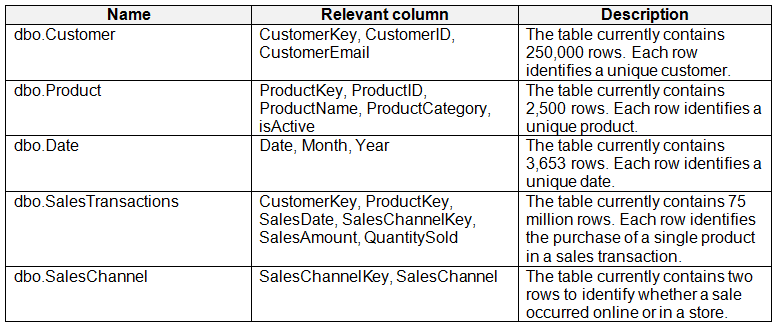
SQLDW contains the following additional tables.

SQLDW contains a view named dbo.CustomerPurchases that creates a distinct list of values from dbo.Customer [customerID], dbo.Customer [CustomerEmail], dbo.Product [ProductID] and dbo.Product [ProductName].
The sales data in SQLDW is updated every 30 minutes. Records in dbo.SalesTransactions are updated in SQLDW up to three days after being created. The records do NOT change after three days.
Power BI -
Litware has a new Power BI tenant that contains an empty workspace named Sales Analytics.
All users have Power BI Premium per user licenses.
IT data analytics are workspace administrators. The IT data analysts will create datasets and reports.
A single imported dataset will be created to support the company’s sales analytics goals. The dataset will be refreshed every 30 minutes.
Requirements -
Analytics Goals -
Litware identifies the following analytics goals:
Provide historical reporting of sales by product and channel over time.
Allow sales managers to perform ad hoc sales reporting with minimal effort.
Perform market basket analysis to understand which products are commonly purchased in the same transaction.
Identify which customers should receive promotional emails based on their likelihood of purchasing promoted products.
Litware plans to monitor the adoption of Power BI reports over time. The company wants custom Power BI usage reporting that includes the percent change of users that view reports in the Sales Analytics workspace each month.
Security Requirements -
Litware identifies the following security requirements for the analytics environment:
All the users in the sales department and the marketing department must be able to see Power BI reports that contain market basket analysis and data about which customers are likely to purchase a product.
Customer contact data in SQLDW and the Power BI dataset must be labeled as Sensitive. Records must be kept of any users that use the sensitive data.
Sales associates must be prevented from seeing the CustomerEmail column in Power BI reports.
Sales managers must be prevented from modifying reports created by other users.
Development Process Requirements
Litware identifies the following development process requirements:
SQLDW and datalake1 will act as the development environment. Once feature development is complete, all entities in synapseworkspace1 will be promoted to a test workspace, and then to a production workspace.
Power BI content must be deployed to test and production by using deployment pipelines.
All SQL scripts must be stored in Azure Repos.
The IT data analysts prefer to build Power BI reports in Synapse Studio.
You need to implement object-level security (OLS) in the Power BI dataset for the sales associates.
Which three actions should you perform in sequence? To answer, move the appropriate actions from the list of actions to the answer area and arrange them in the correct order.
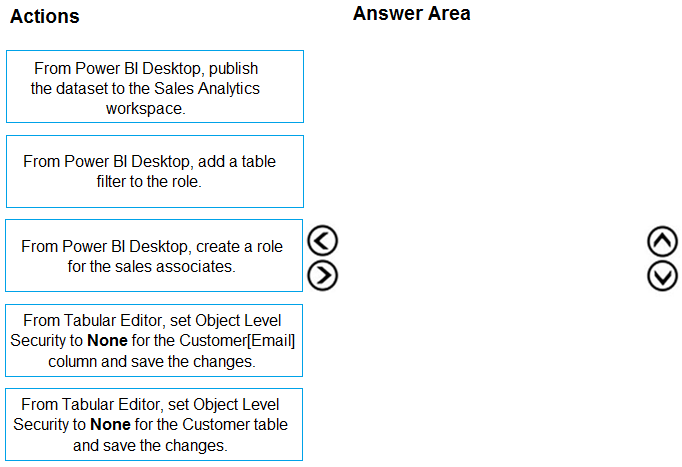
This is a case study. Case studies are not timed separately. You can use as much exam time as you would like to complete each case. However, there may be additional case studies and sections on this exam. You must manage your time to ensure that you are able to complete all questions included on this exam in the time provided.
To answer the questions included in a case study, you will need to reference information that is provided in the case study. Case studies might contain exhibits and other resources that provide more information about the scenario that is described in the case study. Each question is independent of the other questions in this case study.
At the end of this case study, a review screen will appear. This screen allows you to review your answers and to make changes before you move to the next section of the exam. After you begin a new section, you cannot return to this section.
To start the case study -
To display the first question in this case study, click the Next button. Use the buttons in the left pane to explore the content of the case study before you answer the questions. Clicking these buttons displays information such as business requirements, existing environment, and problem statements. If the case study has an All Information tab, note that the information displayed is identical to the information displayed on the subsequent tabs. When you are ready to answer a question, click the Question button to return to the question.
Overview -
Existing environment -
Litware, Inc. is a retail company that sells outdoor recreational goods and accessories. The company sells goods both online and its stores located in six countries.
Azure Resources -
Litware has the following Azure resources:
An Azure Synapse Analytics workspace named synapseworkspace1
An Azure Data Lake Storage Gen2 account named datalake1 that is associated with synapseworkspace1
A Synapse Analytics dedicated SQL pool named SQLDW
Dedicated SQL Pool -
SQLDW contains a dimensional model that contains the following tables.

SQLDW contains the following additional tables.

SQLDW contains a view named dbo.CustomerPurchases that creates a distinct list of values from dbo.Customer [customerID], dbo.Customer [CustomerEmail], dbo.Product [ProductID] and dbo.Product [ProductName].
The sales data in SQLDW is updated every 30 minutes. Records in dbo.SalesTransactions are updated in SQLDW up to three days after being created. The records do NOT change after three days.
Power BI -
Litware has a new Power BI tenant that contains an empty workspace named Sales Analytics.
All users have Power BI Premium per user licenses.
IT data analytics are workspace administrators. The IT data analysts will create datasets and reports.
A single imported dataset will be created to support the company’s sales analytics goals. The dataset will be refreshed every 30 minutes.
Requirements -
Analytics Goals -
Litware identifies the following analytics goals:
Provide historical reporting of sales by product and channel over time.
Allow sales managers to perform ad hoc sales reporting with minimal effort.
Perform market basket analysis to understand which products are commonly purchased in the same transaction.
Identify which customers should receive promotional emails based on their likelihood of purchasing promoted products.
Litware plans to monitor the adoption of Power BI reports over time. The company wants custom Power BI usage reporting that includes the percent change of users that view reports in the Sales Analytics workspace each month.
Security Requirements -
Litware identifies the following security requirements for the analytics environment:
All the users in the sales department and the marketing department must be able to see Power BI reports that contain market basket analysis and data about which customers are likely to purchase a product.
Customer contact data in SQLDW and the Power BI dataset must be labeled as Sensitive. Records must be kept of any users that use the sensitive data.
Sales associates must be prevented from seeing the CustomerEmail column in Power BI reports.
Sales managers must be prevented from modifying reports created by other users.
Development Process Requirements
Litware identifies the following development process requirements:
SQLDW and datalake1 will act as the development environment. Once feature development is complete, all entities in synapseworkspace1 will be promoted to a test workspace, and then to a production workspace.
Power BI content must be deployed to test and production by using deployment pipelines.
All SQL scripts must be stored in Azure Repos.
The IT data analysts prefer to build Power BI reports in Synapse Studio.
You need to implement object-level security (OLS) in the Power BI dataset for the sales associates.
Which three actions should you perform in sequence? To answer, move the appropriate actions from the list of actions to the answer area and arrange them in the correct order.

send
light_mode
delete
Question #12
This is a case study. Case studies are not timed separately. You can use as much exam time as you would like to complete each case. However, there may be additional case studies and sections on this exam. You must manage your time to ensure that you are able to complete all questions included on this exam in the time provided.
To answer the questions included in a case study, you will need to reference information that is provided in the case study. Case studies might contain exhibits and other resources that provide more information about the scenario that is described in the case study. Each question is independent of the other questions in this case study.
At the end of this case study, a review screen will appear. This screen allows you to review your answers and to make changes before you move to the next section of the exam. After you begin a new section, you cannot return to this section.
To start the case study -
To display the first question in this case study, click the Next button. Use the buttons in the left pane to explore the content of the case study before you answer the questions. Clicking these buttons displays information such as business requirements, existing environment, and problem statements. If the case study has an All Information tab, note that the information displayed is identical to the information displayed on the subsequent tabs. When you are ready to answer a question, click the Question button to return to the question.
Overview -
Existing environment -
Litware, Inc. is a retail company that sells outdoor recreational goods and accessories. The company sells goods both online and its stores located in six countries.
Azure Resources -
Litware has the following Azure resources:
An Azure Synapse Analytics workspace named synapseworkspace1
An Azure Data Lake Storage Gen2 account named datalake1 that is associated with synapseworkspace1
A Synapse Analytics dedicated SQL pool named SQLDW
Dedicated SQL Pool -
SQLDW contains a dimensional model that contains the following tables.
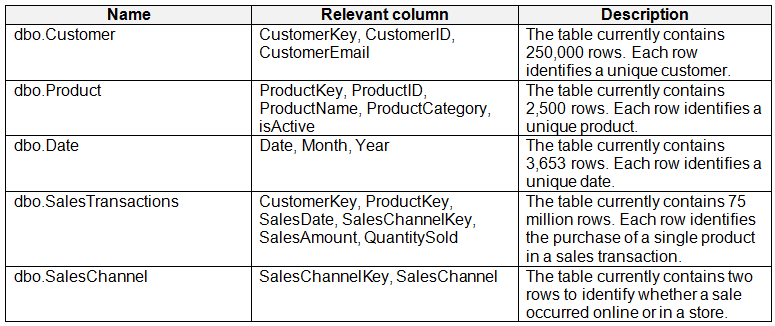
SQLDW contains the following additional tables.

SQLDW contains a view named dbo.CustomerPurchases that creates a distinct list of values from dbo.Customer [customerID], dbo.Customer [CustomerEmail], dbo.Product [ProductID] and dbo.Product [ProductName].
The sales data in SQLDW is updated every 30 minutes. Records in dbo.SalesTransactions are updated in SQLDW up to three days after being created. The records do NOT change after three days.
Power BI -
Litware has a new Power BI tenant that contains an empty workspace named Sales Analytics.
All users have Power BI Premium per user licenses.
IT data analytics are workspace administrators. The IT data analysts will create datasets and reports.
A single imported dataset will be created to support the company’s sales analytics goals. The dataset will be refreshed every 30 minutes.
Requirements -
Analytics Goals -
Litware identifies the following analytics goals:
Provide historical reporting of sales by product and channel over time.
Allow sales managers to perform ad hoc sales reporting with minimal effort.
Perform market basket analysis to understand which products are commonly purchased in the same transaction.
Identify which customers should receive promotional emails based on their likelihood of purchasing promoted products.
Litware plans to monitor the adoption of Power BI reports over time. The company wants custom Power BI usage reporting that includes the percent change of users that view reports in the Sales Analytics workspace each month.
Security Requirements -
Litware identifies the following security requirements for the analytics environment:
All the users in the sales department and the marketing department must be able to see Power BI reports that contain market basket analysis and data about which customers are likely to purchase a product.
Customer contact data in SQLDW and the Power BI dataset must be labeled as Sensitive. Records must be kept of any users that use the sensitive data.
Sales associates must be prevented from seeing the CustomerEmail column in Power BI reports.
Sales managers must be prevented from modifying reports created by other users.
Development Process Requirements
Litware identifies the following development process requirements:
SQLDW and datalake1 will act as the development environment. Once feature development is complete, all entities in synapseworkspace1 will be promoted to a test workspace, and then to a production workspace.
Power BI content must be deployed to test and production by using deployment pipelines.
All SQL scripts must be stored in Azure Repos.
The IT data analysts prefer to build Power BI reports in Synapse Studio.
You need to recommend a solution to ensure that sensitivity labels are applied. The solution must minimize administrative effort.
Which three actions should you include in the recommendation? Each correct answer presents part of the solution.
NOTE: Each correct selection is worth one point.
To answer the questions included in a case study, you will need to reference information that is provided in the case study. Case studies might contain exhibits and other resources that provide more information about the scenario that is described in the case study. Each question is independent of the other questions in this case study.
At the end of this case study, a review screen will appear. This screen allows you to review your answers and to make changes before you move to the next section of the exam. After you begin a new section, you cannot return to this section.
To start the case study -
To display the first question in this case study, click the Next button. Use the buttons in the left pane to explore the content of the case study before you answer the questions. Clicking these buttons displays information such as business requirements, existing environment, and problem statements. If the case study has an All Information tab, note that the information displayed is identical to the information displayed on the subsequent tabs. When you are ready to answer a question, click the Question button to return to the question.
Overview -
Existing environment -
Litware, Inc. is a retail company that sells outdoor recreational goods and accessories. The company sells goods both online and its stores located in six countries.
Azure Resources -
Litware has the following Azure resources:
An Azure Synapse Analytics workspace named synapseworkspace1
An Azure Data Lake Storage Gen2 account named datalake1 that is associated with synapseworkspace1
A Synapse Analytics dedicated SQL pool named SQLDW
Dedicated SQL Pool -
SQLDW contains a dimensional model that contains the following tables.

SQLDW contains the following additional tables.

SQLDW contains a view named dbo.CustomerPurchases that creates a distinct list of values from dbo.Customer [customerID], dbo.Customer [CustomerEmail], dbo.Product [ProductID] and dbo.Product [ProductName].
The sales data in SQLDW is updated every 30 minutes. Records in dbo.SalesTransactions are updated in SQLDW up to three days after being created. The records do NOT change after three days.
Power BI -
Litware has a new Power BI tenant that contains an empty workspace named Sales Analytics.
All users have Power BI Premium per user licenses.
IT data analytics are workspace administrators. The IT data analysts will create datasets and reports.
A single imported dataset will be created to support the company’s sales analytics goals. The dataset will be refreshed every 30 minutes.
Requirements -
Analytics Goals -
Litware identifies the following analytics goals:
Provide historical reporting of sales by product and channel over time.
Allow sales managers to perform ad hoc sales reporting with minimal effort.
Perform market basket analysis to understand which products are commonly purchased in the same transaction.
Identify which customers should receive promotional emails based on their likelihood of purchasing promoted products.
Litware plans to monitor the adoption of Power BI reports over time. The company wants custom Power BI usage reporting that includes the percent change of users that view reports in the Sales Analytics workspace each month.
Security Requirements -
Litware identifies the following security requirements for the analytics environment:
All the users in the sales department and the marketing department must be able to see Power BI reports that contain market basket analysis and data about which customers are likely to purchase a product.
Customer contact data in SQLDW and the Power BI dataset must be labeled as Sensitive. Records must be kept of any users that use the sensitive data.
Sales associates must be prevented from seeing the CustomerEmail column in Power BI reports.
Sales managers must be prevented from modifying reports created by other users.
Development Process Requirements
Litware identifies the following development process requirements:
SQLDW and datalake1 will act as the development environment. Once feature development is complete, all entities in synapseworkspace1 will be promoted to a test workspace, and then to a production workspace.
Power BI content must be deployed to test and production by using deployment pipelines.
All SQL scripts must be stored in Azure Repos.
The IT data analysts prefer to build Power BI reports in Synapse Studio.
You need to recommend a solution to ensure that sensitivity labels are applied. The solution must minimize administrative effort.
Which three actions should you include in the recommendation? Each correct answer presents part of the solution.
NOTE: Each correct selection is worth one point.
- AFrom the Power BI Admin portal, set Allow users to apply sensitivity labels for Power BI content to Enabled.Most Voted
- BFrom the Power BI Admin portal, set Apply sensitivity labels from data sources to their data in Power BI to Enabled.Most Voted
- CIn SQLDW, apply sensitivity labels to the columns in the Customer and CustomersWithProductScore tables.Most Voted
- DIn the Power BI datasets, apply sensitivity labels to the columns in the Customer and CustomersWithProductScore tables.
- EFrom the Power BI Admin portal, set Make certified content discoverable to Enabled.
Correct Answer:
ADE
ADE
send
light_mode
delete
Question #13
This is a case study. Case studies are not timed separately. You can use as much exam time as you would like to complete each case. However, there may be additional case studies and sections on this exam. You must manage your time to ensure that you are able to complete all questions included on this exam in the time provided.
To answer the questions included in a case study, you will need to reference information that is provided in the case study. Case studies might contain exhibits and other resources that provide more information about the scenario that is described in the case study. Each question is independent of the other questions in this case study.
At the end of this case study, a review screen will appear. This screen allows you to review your answers and to make changes before you move to the next section of the exam. After you begin a new section, you cannot return to this section.
To start the case study -
To display the first question in this case study, click the Next button. Use the buttons in the left pane to explore the content of the case study before you answer the questions. Clicking these buttons displays information such as business requirements, existing environment, and problem statements. If the case study has an All Information tab, note that the information displayed is identical to the information displayed on the subsequent tabs. When you are ready to answer a question, click the Question button to return to the question.
Overview -
Existing environment -
Litware, Inc. is a retail company that sells outdoor recreational goods and accessories. The company sells goods both online and its stores located in six countries.
Azure Resources -
Litware has the following Azure resources:
An Azure Synapse Analytics workspace named synapseworkspace1
An Azure Data Lake Storage Gen2 account named datalake1 that is associated with synapseworkspace1
A Synapse Analytics dedicated SQL pool named SQLDW
Dedicated SQL Pool -
SQLDW contains a dimensional model that contains the following tables.
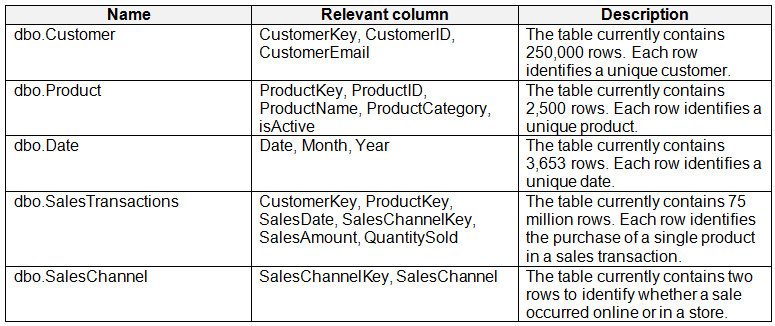
SQLDW contains the following additional tables.

SQLDW contains a view named dbo.CustomerPurchases that creates a distinct list of values from dbo.Customer [customerID], dbo.Customer [CustomerEmail], dbo.Product [ProductID] and dbo.Product [ProductName].
The sales data in SQLDW is updated every 30 minutes. Records in dbo.SalesTransactions are updated in SQLDW up to three days after being created. The records do NOT change after three days.
Power BI -
Litware has a new Power BI tenant that contains an empty workspace named Sales Analytics.
All users have Power BI Premium per user licenses.
IT data analytics are workspace administrators. The IT data analysts will create datasets and reports.
A single imported dataset will be created to support the company’s sales analytics goals. The dataset will be refreshed every 30 minutes.
Requirements -
Analytics Goals -
Litware identifies the following analytics goals:
Provide historical reporting of sales by product and channel over time.
Allow sales managers to perform ad hoc sales reporting with minimal effort.
Perform market basket analysis to understand which products are commonly purchased in the same transaction.
Identify which customers should receive promotional emails based on their likelihood of purchasing promoted products.
Litware plans to monitor the adoption of Power BI reports over time. The company wants custom Power BI usage reporting that includes the percent change of users that view reports in the Sales Analytics workspace each month.
Security Requirements -
Litware identifies the following security requirements for the analytics environment:
All the users in the sales department and the marketing department must be able to see Power BI reports that contain market basket analysis and data about which customers are likely to purchase a product.
Customer contact data in SQLDW and the Power BI dataset must be labeled as Sensitive. Records must be kept of any users that use the sensitive data.
Sales associates must be prevented from seeing the CustomerEmail column in Power BI reports.
Sales managers must be prevented from modifying reports created by other users.
Development Process Requirements
Litware identifies the following development process requirements:
SQLDW and datalake1 will act as the development environment. Once feature development is complete, all entities in synapseworkspace1 will be promoted to a test workspace, and then to a production workspace.
Power BI content must be deployed to test and production by using deployment pipelines.
All SQL scripts must be stored in Azure Repos.
The IT data analysts prefer to build Power BI reports in Synapse Studio.
How should you configure the Power BI dataset refresh for the dbo.SalesTransactions table?
To answer the questions included in a case study, you will need to reference information that is provided in the case study. Case studies might contain exhibits and other resources that provide more information about the scenario that is described in the case study. Each question is independent of the other questions in this case study.
At the end of this case study, a review screen will appear. This screen allows you to review your answers and to make changes before you move to the next section of the exam. After you begin a new section, you cannot return to this section.
To start the case study -
To display the first question in this case study, click the Next button. Use the buttons in the left pane to explore the content of the case study before you answer the questions. Clicking these buttons displays information such as business requirements, existing environment, and problem statements. If the case study has an All Information tab, note that the information displayed is identical to the information displayed on the subsequent tabs. When you are ready to answer a question, click the Question button to return to the question.
Overview -
Existing environment -
Litware, Inc. is a retail company that sells outdoor recreational goods and accessories. The company sells goods both online and its stores located in six countries.
Azure Resources -
Litware has the following Azure resources:
An Azure Synapse Analytics workspace named synapseworkspace1
An Azure Data Lake Storage Gen2 account named datalake1 that is associated with synapseworkspace1
A Synapse Analytics dedicated SQL pool named SQLDW
Dedicated SQL Pool -
SQLDW contains a dimensional model that contains the following tables.

SQLDW contains the following additional tables.

SQLDW contains a view named dbo.CustomerPurchases that creates a distinct list of values from dbo.Customer [customerID], dbo.Customer [CustomerEmail], dbo.Product [ProductID] and dbo.Product [ProductName].
The sales data in SQLDW is updated every 30 minutes. Records in dbo.SalesTransactions are updated in SQLDW up to three days after being created. The records do NOT change after three days.
Power BI -
Litware has a new Power BI tenant that contains an empty workspace named Sales Analytics.
All users have Power BI Premium per user licenses.
IT data analytics are workspace administrators. The IT data analysts will create datasets and reports.
A single imported dataset will be created to support the company’s sales analytics goals. The dataset will be refreshed every 30 minutes.
Requirements -
Analytics Goals -
Litware identifies the following analytics goals:
Provide historical reporting of sales by product and channel over time.
Allow sales managers to perform ad hoc sales reporting with minimal effort.
Perform market basket analysis to understand which products are commonly purchased in the same transaction.
Identify which customers should receive promotional emails based on their likelihood of purchasing promoted products.
Litware plans to monitor the adoption of Power BI reports over time. The company wants custom Power BI usage reporting that includes the percent change of users that view reports in the Sales Analytics workspace each month.
Security Requirements -
Litware identifies the following security requirements for the analytics environment:
All the users in the sales department and the marketing department must be able to see Power BI reports that contain market basket analysis and data about which customers are likely to purchase a product.
Customer contact data in SQLDW and the Power BI dataset must be labeled as Sensitive. Records must be kept of any users that use the sensitive data.
Sales associates must be prevented from seeing the CustomerEmail column in Power BI reports.
Sales managers must be prevented from modifying reports created by other users.
Development Process Requirements
Litware identifies the following development process requirements:
SQLDW and datalake1 will act as the development environment. Once feature development is complete, all entities in synapseworkspace1 will be promoted to a test workspace, and then to a production workspace.
Power BI content must be deployed to test and production by using deployment pipelines.
All SQL scripts must be stored in Azure Repos.
The IT data analysts prefer to build Power BI reports in Synapse Studio.
How should you configure the Power BI dataset refresh for the dbo.SalesTransactions table?
- Aan incremental refresh of Product where the ModifiedDate value is during the last three days.
- Ban incremental refresh of dbo.SalesTransactions where the SalesDate value is during the last three days.Most Voted
- Ca full refresh of all the tables
- Dan incremental refresh of dbo.SalesTransactions where the SalesDate value is during the last hour.
Correct Answer:
B
B
send
light_mode
delete
Question #14
This is a case study. Case studies are not timed separately. You can use as much exam time as you would like to complete each case. However, there may be additional case studies and sections on this exam. You must manage your time to ensure that you are able to complete all questions included on this exam in the time provided.
To answer the questions included in a case study, you will need to reference information that is provided in the case study. Case studies might contain exhibits and other resources that provide more information about the scenario that is described in the case study. Each question is independent of the other questions in this case study.
At the end of this case study, a review screen will appear. This screen allows you to review your answers and to make changes before you move to the next section of the exam. After you begin a new section, you cannot return to this section.
To start the case study -
To display the first question in this case study, click the Next button. Use the buttons in the left pane to explore the content of the case study before you answer the questions. Clicking these buttons displays information such as business requirements, existing environment, and problem statements. If the case study has an All Information tab, note that the information displayed is identical to the information displayed on the subsequent tabs. When you are ready to answer a question, click the Question button to return to the question.
Overview -
Existing environment -
Litware, Inc. is a retail company that sells outdoor recreational goods and accessories. The company sells goods both online and its stores located in six countries.
Azure Resources -
Litware has the following Azure resources:
An Azure Synapse Analytics workspace named synapseworkspace1
An Azure Data Lake Storage Gen2 account named datalake1 that is associated with synapseworkspace1
A Synapse Analytics dedicated SQL pool named SQLDW
Dedicated SQL Pool -
SQLDW contains a dimensional model that contains the following tables.
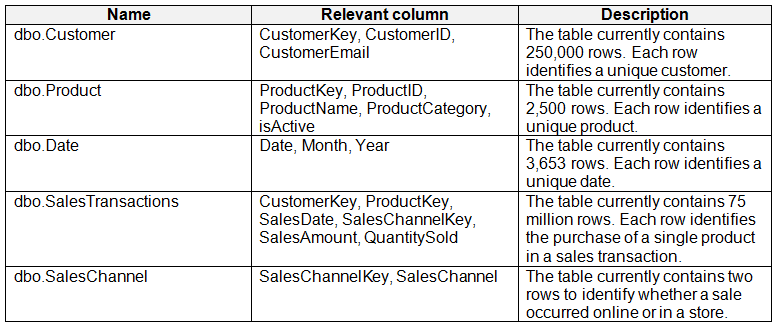
SQLDW contains the following additional tables.

SQLDW contains a view named dbo.CustomerPurchases that creates a distinct list of values from dbo.Customer [customerID], dbo.Customer [CustomerEmail], dbo.Product [ProductID] and dbo.Product [ProductName].
The sales data in SQLDW is updated every 30 minutes. Records in dbo.SalesTransactions are updated in SQLDW up to three days after being created. The records do NOT change after three days.
Power BI -
Litware has a new Power BI tenant that contains an empty workspace named Sales Analytics.
All users have Power BI Premium per user licenses.
IT data analytics are workspace administrators. The IT data analysts will create datasets and reports.
A single imported dataset will be created to support the company’s sales analytics goals. The dataset will be refreshed every 30 minutes.
Requirements -
Analytics Goals -
Litware identifies the following analytics goals:
Provide historical reporting of sales by product and channel over time.
Allow sales managers to perform ad hoc sales reporting with minimal effort.
Perform market basket analysis to understand which products are commonly purchased in the same transaction.
Identify which customers should receive promotional emails based on their likelihood of purchasing promoted products.
Litware plans to monitor the adoption of Power BI reports over time. The company wants custom Power BI usage reporting that includes the percent change of users that view reports in the Sales Analytics workspace each month.
Security Requirements -
Litware identifies the following security requirements for the analytics environment:
All the users in the sales department and the marketing department must be able to see Power BI reports that contain market basket analysis and data about which customers are likely to purchase a product.
Customer contact data in SQLDW and the Power BI dataset must be labeled as Sensitive. Records must be kept of any users that use the sensitive data.
Sales associates must be prevented from seeing the CustomerEmail column in Power BI reports.
Sales managers must be prevented from modifying reports created by other users.
Development Process Requirements
Litware identifies the following development process requirements:
SQLDW and datalake1 will act as the development environment. Once feature development is complete, all entities in synapseworkspace1 will be promoted to a test workspace, and then to a production workspace.
Power BI content must be deployed to test and production by using deployment pipelines.
All SQL scripts must be stored in Azure Repos.
The IT data analysts prefer to build Power BI reports in Synapse Studio.
What should you configure in the deployment pipeline?
To answer the questions included in a case study, you will need to reference information that is provided in the case study. Case studies might contain exhibits and other resources that provide more information about the scenario that is described in the case study. Each question is independent of the other questions in this case study.
At the end of this case study, a review screen will appear. This screen allows you to review your answers and to make changes before you move to the next section of the exam. After you begin a new section, you cannot return to this section.
To start the case study -
To display the first question in this case study, click the Next button. Use the buttons in the left pane to explore the content of the case study before you answer the questions. Clicking these buttons displays information such as business requirements, existing environment, and problem statements. If the case study has an All Information tab, note that the information displayed is identical to the information displayed on the subsequent tabs. When you are ready to answer a question, click the Question button to return to the question.
Overview -
Existing environment -
Litware, Inc. is a retail company that sells outdoor recreational goods and accessories. The company sells goods both online and its stores located in six countries.
Azure Resources -
Litware has the following Azure resources:
An Azure Synapse Analytics workspace named synapseworkspace1
An Azure Data Lake Storage Gen2 account named datalake1 that is associated with synapseworkspace1
A Synapse Analytics dedicated SQL pool named SQLDW
Dedicated SQL Pool -
SQLDW contains a dimensional model that contains the following tables.

SQLDW contains the following additional tables.

SQLDW contains a view named dbo.CustomerPurchases that creates a distinct list of values from dbo.Customer [customerID], dbo.Customer [CustomerEmail], dbo.Product [ProductID] and dbo.Product [ProductName].
The sales data in SQLDW is updated every 30 minutes. Records in dbo.SalesTransactions are updated in SQLDW up to three days after being created. The records do NOT change after three days.
Power BI -
Litware has a new Power BI tenant that contains an empty workspace named Sales Analytics.
All users have Power BI Premium per user licenses.
IT data analytics are workspace administrators. The IT data analysts will create datasets and reports.
A single imported dataset will be created to support the company’s sales analytics goals. The dataset will be refreshed every 30 minutes.
Requirements -
Analytics Goals -
Litware identifies the following analytics goals:
Provide historical reporting of sales by product and channel over time.
Allow sales managers to perform ad hoc sales reporting with minimal effort.
Perform market basket analysis to understand which products are commonly purchased in the same transaction.
Identify which customers should receive promotional emails based on their likelihood of purchasing promoted products.
Litware plans to monitor the adoption of Power BI reports over time. The company wants custom Power BI usage reporting that includes the percent change of users that view reports in the Sales Analytics workspace each month.
Security Requirements -
Litware identifies the following security requirements for the analytics environment:
All the users in the sales department and the marketing department must be able to see Power BI reports that contain market basket analysis and data about which customers are likely to purchase a product.
Customer contact data in SQLDW and the Power BI dataset must be labeled as Sensitive. Records must be kept of any users that use the sensitive data.
Sales associates must be prevented from seeing the CustomerEmail column in Power BI reports.
Sales managers must be prevented from modifying reports created by other users.
Development Process Requirements
Litware identifies the following development process requirements:
SQLDW and datalake1 will act as the development environment. Once feature development is complete, all entities in synapseworkspace1 will be promoted to a test workspace, and then to a production workspace.
Power BI content must be deployed to test and production by using deployment pipelines.
All SQL scripts must be stored in Azure Repos.
The IT data analysts prefer to build Power BI reports in Synapse Studio.
What should you configure in the deployment pipeline?
- Aa selective deployment
- Bauto-binding
- Ca backward deployment
- Da data source ruleMost Voted
Correct Answer:
D
D
send
light_mode
delete
Question #15
HOTSPOT -
This is a case study. Case studies are not timed separately. You can use as much exam time as you would like to complete each case. However, there may be additional case studies and sections on this exam. You must manage your time to ensure that you are able to complete all questions included on this exam in the time provided.
To answer the questions included in a case study, you will need to reference information that is provided in the case study. Case studies might contain exhibits and other resources that provide more information about the scenario that is described in the case study. Each question is independent of the other questions in this case study.
At the end of this case study, a review screen will appear. This screen allows you to review your answers and to make changes before you move to the next section of the exam. After you begin a new section, you cannot return to this section.
To start the case study -
To display the first question in this case study, click the Next button. Use the buttons in the left pane to explore the content of the case study before you answer the questions. Clicking these buttons displays information such as business requirements, existing environment, and problem statements. If the case study has an All Information tab, note that the information displayed is identical to the information displayed on the subsequent tabs. When you are ready to answer a question, click the Question button to return to the question.
Overview -
Existing environment -
Litware, Inc. is a retail company that sells outdoor recreational goods and accessories. The company sells goods both online and its stores located in six countries.
Azure Resources -
Litware has the following Azure resources:
An Azure Synapse Analytics workspace named synapseworkspace1
An Azure Data Lake Storage Gen2 account named datalake1 that is associated with synapseworkspace1
A Synapse Analytics dedicated SQL pool named SQLDW
Dedicated SQL Pool -
SQLDW contains a dimensional model that contains the following tables.
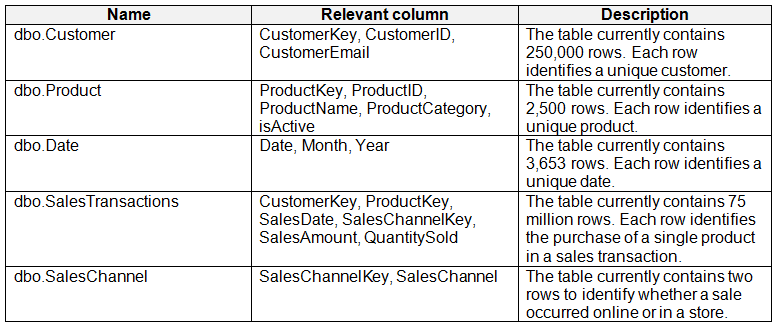
SQLDW contains the following additional tables.

SQLDW contains a view named dbo.CustomerPurchases that creates a distinct list of values from dbo.Customer [customerID], dbo.Customer [CustomerEmail], dbo.Product [ProductID] and dbo.Product [ProductName].
The sales data in SQLDW is updated every 30 minutes. Records in dbo.SalesTransactions are updated in SQLDW up to three days after being created. The records do NOT change after three days.
Power BI -
Litware has a new Power BI tenant that contains an empty workspace named Sales Analytics.
All users have Power BI Premium per user licenses.
IT data analytics are workspace administrators. The IT data analysts will create datasets and reports.
A single imported dataset will be created to support the company’s sales analytics goals. The dataset will be refreshed every 30 minutes.
Requirements -
Analytics Goals -
Litware identifies the following analytics goals:
Provide historical reporting of sales by product and channel over time.
Allow sales managers to perform ad hoc sales reporting with minimal effort.
Perform market basket analysis to understand which products are commonly purchased in the same transaction.
Identify which customers should receive promotional emails based on their likelihood of purchasing promoted products.
Litware plans to monitor the adoption of Power BI reports over time. The company wants custom Power BI usage reporting that includes the percent change of users that view reports in the Sales Analytics workspace each month.
Security Requirements -
Litware identifies the following security requirements for the analytics environment:
All the users in the sales department and the marketing department must be able to see Power BI reports that contain market basket analysis and data about which customers are likely to purchase a product.
Customer contact data in SQLDW and the Power BI dataset must be labeled as Sensitive. Records must be kept of any users that use the sensitive data.
Sales associates must be prevented from seeing the CustomerEmail column in Power BI reports.
Sales managers must be prevented from modifying reports created by other users.
Development Process Requirements
Litware identifies the following development process requirements:
SQLDW and datalake1 will act as the development environment. Once feature development is complete, all entities in synapseworkspace1 will be promoted to a test workspace, and then to a production workspace.
Power BI content must be deployed to test and production by using deployment pipelines.
All SQL scripts must be stored in Azure Repos.
The IT data analysts prefer to build Power BI reports in Synapse Studio.
You need to populate the CustomersWithProductScore table.
How should you complete the stored procedure? To answer, select the appropriate options in the answer area.
NOTE: Each correct selection is worth one point.
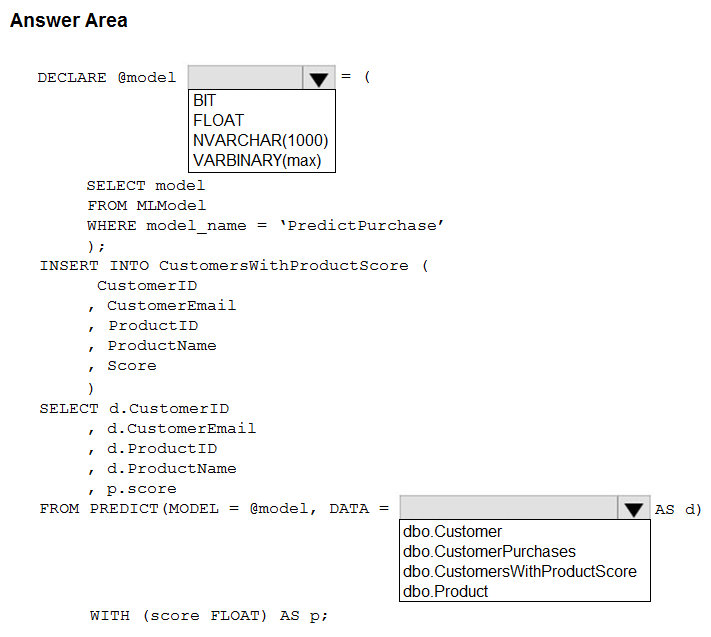
This is a case study. Case studies are not timed separately. You can use as much exam time as you would like to complete each case. However, there may be additional case studies and sections on this exam. You must manage your time to ensure that you are able to complete all questions included on this exam in the time provided.
To answer the questions included in a case study, you will need to reference information that is provided in the case study. Case studies might contain exhibits and other resources that provide more information about the scenario that is described in the case study. Each question is independent of the other questions in this case study.
At the end of this case study, a review screen will appear. This screen allows you to review your answers and to make changes before you move to the next section of the exam. After you begin a new section, you cannot return to this section.
To start the case study -
To display the first question in this case study, click the Next button. Use the buttons in the left pane to explore the content of the case study before you answer the questions. Clicking these buttons displays information such as business requirements, existing environment, and problem statements. If the case study has an All Information tab, note that the information displayed is identical to the information displayed on the subsequent tabs. When you are ready to answer a question, click the Question button to return to the question.
Overview -
Existing environment -
Litware, Inc. is a retail company that sells outdoor recreational goods and accessories. The company sells goods both online and its stores located in six countries.
Azure Resources -
Litware has the following Azure resources:
An Azure Synapse Analytics workspace named synapseworkspace1
An Azure Data Lake Storage Gen2 account named datalake1 that is associated with synapseworkspace1
A Synapse Analytics dedicated SQL pool named SQLDW
Dedicated SQL Pool -
SQLDW contains a dimensional model that contains the following tables.

SQLDW contains the following additional tables.

SQLDW contains a view named dbo.CustomerPurchases that creates a distinct list of values from dbo.Customer [customerID], dbo.Customer [CustomerEmail], dbo.Product [ProductID] and dbo.Product [ProductName].
The sales data in SQLDW is updated every 30 minutes. Records in dbo.SalesTransactions are updated in SQLDW up to three days after being created. The records do NOT change after three days.
Power BI -
Litware has a new Power BI tenant that contains an empty workspace named Sales Analytics.
All users have Power BI Premium per user licenses.
IT data analytics are workspace administrators. The IT data analysts will create datasets and reports.
A single imported dataset will be created to support the company’s sales analytics goals. The dataset will be refreshed every 30 minutes.
Requirements -
Analytics Goals -
Litware identifies the following analytics goals:
Provide historical reporting of sales by product and channel over time.
Allow sales managers to perform ad hoc sales reporting with minimal effort.
Perform market basket analysis to understand which products are commonly purchased in the same transaction.
Identify which customers should receive promotional emails based on their likelihood of purchasing promoted products.
Litware plans to monitor the adoption of Power BI reports over time. The company wants custom Power BI usage reporting that includes the percent change of users that view reports in the Sales Analytics workspace each month.
Security Requirements -
Litware identifies the following security requirements for the analytics environment:
All the users in the sales department and the marketing department must be able to see Power BI reports that contain market basket analysis and data about which customers are likely to purchase a product.
Customer contact data in SQLDW and the Power BI dataset must be labeled as Sensitive. Records must be kept of any users that use the sensitive data.
Sales associates must be prevented from seeing the CustomerEmail column in Power BI reports.
Sales managers must be prevented from modifying reports created by other users.
Development Process Requirements
Litware identifies the following development process requirements:
SQLDW and datalake1 will act as the development environment. Once feature development is complete, all entities in synapseworkspace1 will be promoted to a test workspace, and then to a production workspace.
Power BI content must be deployed to test and production by using deployment pipelines.
All SQL scripts must be stored in Azure Repos.
The IT data analysts prefer to build Power BI reports in Synapse Studio.
You need to populate the CustomersWithProductScore table.
How should you complete the stored procedure? To answer, select the appropriate options in the answer area.
NOTE: Each correct selection is worth one point.

send
light_mode
delete
All Pages

